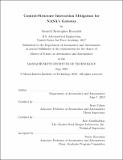| dc.contributor.advisor | Kerri Cahoy and Ravi Gondhalekar. | en_US |
| dc.contributor.author | Reynolds, Daniel Christopher. | en_US |
| dc.contributor.other | Massachusetts Institute of Technology. Department of Aeronautics and Astronautics. | en_US |
| dc.date.accessioned | 2019-10-04T21:30:57Z | |
| dc.date.available | 2019-10-04T21:30:57Z | |
| dc.date.copyright | 2019 | en_US |
| dc.date.issued | 2019 | en_US |
| dc.identifier.uri | https://hdl.handle.net/1721.1/122380 | |
| dc.description | This electronic version was submitted by the student author. The certified thesis is available in the Institute Archives and Special Collections. | en_US |
| dc.description | Thesis: S.M., Massachusetts Institute of Technology, Department of Aeronautics and Astronautics, 2019 | en_US |
| dc.description | Cataloged from student-submitted PDF version of thesis. | en_US |
| dc.description | Includes bibliographical references (pages 127-134). | en_US |
| dc.description.abstract | The Gateway is an advanced National Aeronautics and Space Administration (NASA) concept for a multi-module space station to be placed in a near rectilinear halo orbit around the Moon sometime in the next decade. The first module of the Gateway is known as the Power and Propulsion Element (PPE), and is set to launch in 2022. As the station's first module, the PPE will be responsible for providing the Gateway with "electrical power, communications, attitude control, orbit maintenance, and the ability to change orbits" [16]. Control of the Gateway represents a complicated and unique control problem due to the space-craft's status as a large, multi-modular spacecraft; it will have multiple dominant structural modes from its comprising elements: modules, external payloads, solar arrays, a robotic arm, visiting spacecraft, etc [31]. Other spacecraft in this class include the Space Shuttle, the Mir space station, and the International Space Station (ISS). | en_US |
| dc.description.abstract | The field that pertains to the "coupling" of control inputs and the resultant structural dynamics is known as "Control-Structure Interaction (CSI)" [22], and developing CSI mitigation strategies from induced propulsive and non-propulsive actuation has become an important objective for control systems engineers working on large, flexible space structures today. The current standard for CSI management is evident in the recently retired Space Shuttle's flight control system: a phase-plane attitude control loop with notch filters on the feedback channel that enabled docked operations with the Mir space station and the ISS. However, when unconstrained by the Shuttle's architecture and freed to investigate more modernized and adaptable control methods, additional options arise as feasible candidates for Gateway CSI mitigation. | en_US |
| dc.description.abstract | For example, a Linear Quadratic Regulator (LQR) provides the basis for individual state vector cost weighting, so that steps can be taken to more directly target the vibrations resulting from multiple structural elements. A Frequency Weighted Linear Quadratic Regulator (FWLQR) extends the functionality of a LQR by enabling the direct penalization of specified frequencies in order to shape the system's dynamic responses. The Model Predictive Control (MPC) optimization-based approach supplements the frequency-weighted LQR by adding input and output constraint-handling capabilities. Out of all of the CSI mitigation strategies evaluated, MPC appears to be the optimum candidate for large, flexible space structure CSI mitigation for its adaptability, flexibility, and relative performance. The views expressed in this thesis are those of the author and do not reflect the official policy or position of the United States Air Force, Department of Defense, or the U.S. Government. | en_US |
| dc.description.statementofresponsibility | by Daniel Christopher Reynolds. | en_US |
| dc.format.extent | 134 pages | en_US |
| dc.language.iso | eng | en_US |
| dc.publisher | Massachusetts Institute of Technology | en_US |
| dc.rights | MIT theses are protected by copyright. They may be viewed, downloaded, or printed from this source but further reproduction or distribution in any format is prohibited without written permission. | en_US |
| dc.rights.uri | http://dspace.mit.edu/handle/1721.1/7582 | en_US |
| dc.subject | Aeronautics and Astronautics. | en_US |
| dc.title | Control-structure interaction mitigation for NASA's Gateway | en_US |
| dc.type | Thesis | en_US |
| dc.description.degree | S.M. | en_US |
| dc.contributor.department | Massachusetts Institute of Technology. Department of Aeronautics and Astronautics | en_US |
| dc.identifier.oclc | 1119733254 | en_US |
| dc.description.collection | S.M. Massachusetts Institute of Technology, Department of Aeronautics and Astronautics | en_US |
| dspace.imported | 2019-10-04T21:30:56Z | en_US |
| mit.thesis.degree | Master | en_US |
| mit.thesis.department | Aero | en_US |
